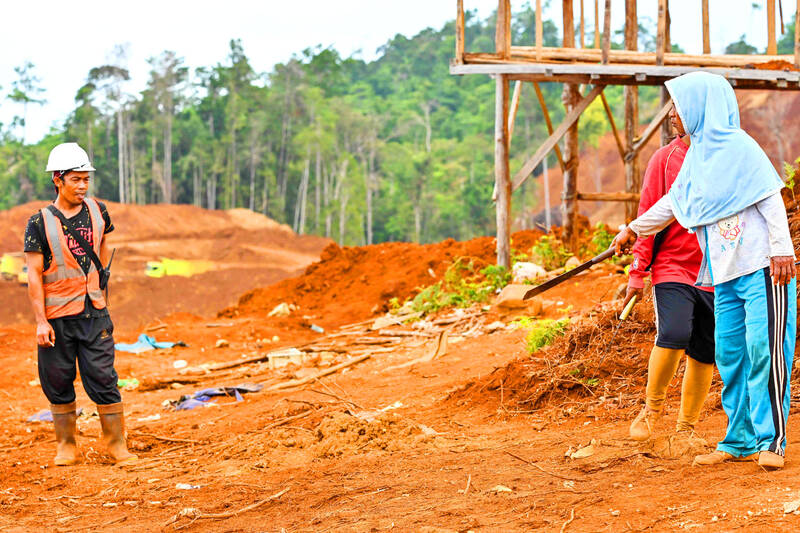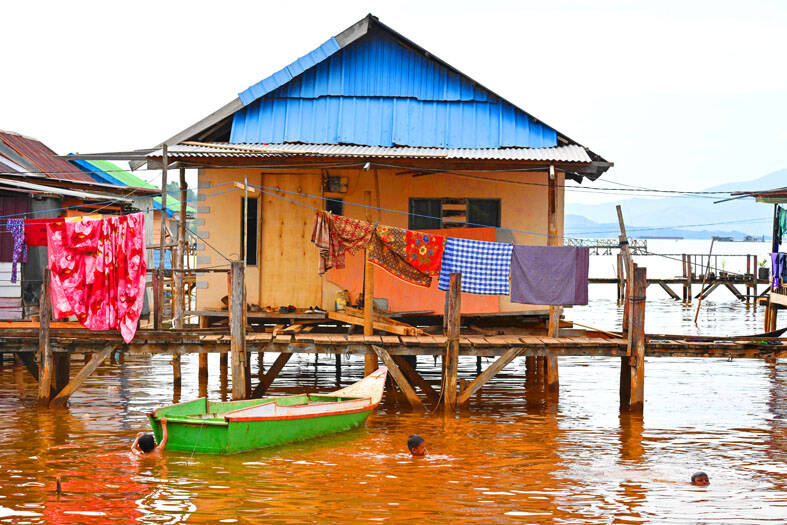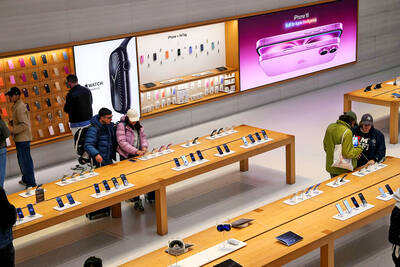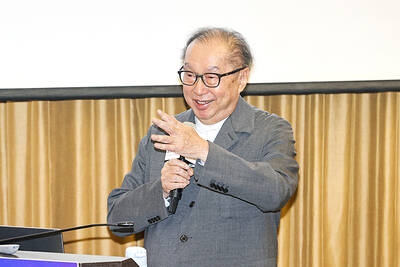Three women with machetes stood guard at their farm hilltop on Indonesia’s Wawonii Island, directing their blades toward the nickel miners working in the forest clearing below.
“I pointed the machete at their faces. I told them: ‘If you scratch this land, heads will fly, we will defend this land to the death,’” 42-year-old villager Royani said, recounting an encounter with some of the miners.
The dig site is part of a huge rush to Indonesia, the world’s largest nickel producer, by domestic and foreign enterprises to mine the critical component used in electric vehicle batteries.

Photo: AFP
Residents and rights groups say that the boom threatens farmers’ land rights and harms the environment in areas such as Wawonii in the resource-rich Sulawesi region, which is home to black macaques, maleo birds and tarsier primates.
Facing the prospect of losing their land and livelihood, about a dozen Wawonii villagers take turns keeping watch from a hut surrounded by clove trees, waiting for trespassers as machinery roars below.
Royani, who goes by one name, joined the effort to safeguard the land after an Indonesian firm cleared hundreds of her family’s tropical spice trees in January.

Photo: AFP
“When we saw there was nothing left, we were destroyed,” she said.
Royani said she wants to protect not just her family’s land from further encroachment, but also her neighbors’.
However, the farmers are up against formidable adversaries.
Soaring global demand for metals used in lithium-ion batteries and stainless steel has pushed major economies such as China and South Korea, alongside electric vehicle giant Tesla Inc and Brazilian mining company Vale SA, to zero in on Indonesia.
Dozens of nickel processing plants now pepper Sulawesi — one of the world’s largest islands — and many more projects have been announced.
Nickel miner PT Gema Kreasi Perdana (PT GKP), owned by one of Indonesia’s wealthiest families, has two concessions on Wawonii totaling 1,800 hectares.
Islanders said it is trying to expand further, with employees repeatedly approaching them for land talks they never asked for.
PT GKP, the Indonesian Ministry of Energy and Mineral Resources and the local energy agency in southeast Sulawesi all declined to comment for this story.
“Even for 1 billion rupiah [US$65,045], I don’t want to sell,” said cashew grower Hastati, 42, whose land has already been partially cleared.
Several protesters in Wawonii have been detained after the land disputes sparked demonstrations, riots and, in some cases, armed confrontations.
Hastoma, a 37-year-old coconut farmer, said he was detained for 45 days last year after clashes between villagers and miners.
Other villagers have blocked miners’ vehicles and set heavy equipment on fire, while some have held miners hostage, restraining them with ropes for up to 12 hours.
“If I keep quiet ... where we live will be destroyed,” Hastoma said, adding that two hectares of his land were seized after his release.
“I will continue to fight to defend our area,” he said.
While land registers in many parts of Indonesia are poorly managed, a presidential decree issued in 2018 recognized farmers’ rights on state lands they use. Citing a 2007 law designed to protect coastal areas and small islands like Wawonii, courts have on several occasions ruled in favor of plaintiffs contesting mining investments.
However, Jakarta is leveraging its resources to entice investors, with many land disputes stemming from overlapping claims due to a lack of adequate ownership checks.
“The problem is permits are often unilaterally issued” by the government, said Benni Wijaya, head of knowledge management and campaigns at the Consortium for Agrarian Reform advocacy group.
“After the permit is issued, it turns out that people have been cultivating the land for years. This is what drives these conflicts,” he added.
Among the leading international investors are Chinese companies.
Indonesian government data showed that Chinese firms pumped US$8.2 billion into the country last year — more than double the 2021 figure of US$3.1 billion.
In central Sulawesi, Chinese companies have set up their own nickel ore processing facilities and even built a nickel museum.
The investments have come at a cost, worsening pollution and stoking tensions over poor working conditions at Chinese-run facilities, including a deadly January riot.
The southeastern Sulawesi coastline has borne the brunt of the environmental impact of the mines.
In a village in the Pomalaa region of the island, stilt houses sit above rust-red sludge where children swim in murky waters.
Contaminated soil from nickel mines brought down the hills by rain has turned the coastal waters of the Pacific Ocean a deep red color, locals said.
“When there were no mines, the water was not like this. It was clean,” villager Guntur, 33, said.
State-owned firm PT Aneka Tambang Tbk is among the firms that have mining concessions in the area.
PT Aneka corporate secretary Syarif Faisal Alkadrie said that “there has been no mining activity” there.
“The company is always committed to implementing good mining practice principles” in its operations, he said, adding that other companies had concessions and operated nearby.
Fishers have also been affected by the nickel pollution, and Asep Solihin said he now has to sail much further than he used to for a catch.
“We are only just able to survive,” said the 44-year-old, who has been involved in protests against the mining projects. “Up there it’s mined, down there is mud. What about the next generation?”
Not all the locals oppose the projects, with some securing work thanks to the investments, while others have seen their small businesses’ profits rise.
Sasto Utomo, 56, built a stall near the smelter in Morosi, where he sells black pepper crab and fried rice.
“I fully support the factories. Previously we could not sell. Thank God my income has increased,” he said, adding he had bought a house and farmland with his earnings.
Indonesia is Southeast Asia’s largest economy, and the World Bank says it has made huge strides in poverty reduction in the past few years.
In a speech last month, Indonesian President Joko Widodo said the country would “keep moving” with the aim of reaching developed nation status.
Farmers like Royani said they would refuse to bow to the industrial drive.
“What can we do?” she said, adding that she spends much of her day standing guard against trespassers.
They have been forced to defend their spaces or potentially lose them forever, said Kisran Makati, director of the Southeast Sulawesi Human Rights Study and Advocacy Center.
“There is no other choice,” he said.

BYPASSING CHINA TARIFFS: In the first five months of this year, Foxconn sent US$4.4bn of iPhones to the US from India, compared with US$3.7bn in the whole of last year Nearly all the iPhones exported by Foxconn Technology Group (富士康科技集團) from India went to the US between March and last month, customs data showed, far above last year’s average of 50 percent and a clear sign of Apple Inc’s efforts to bypass high US tariffs imposed on China. The numbers, being reported by Reuters for the first time, show that Apple has realigned its India exports to almost exclusively serve the US market, when previously the devices were more widely distributed to nations including the Netherlands and the Czech Republic. During March to last month, Foxconn, known as Hon Hai Precision Industry

Taiwan Semiconductor Manufacturing Co (TSMC, 台積電) and the University of Tokyo (UTokyo) yesterday announced the launch of the TSMC-UTokyo Lab to promote advanced semiconductor research, education and talent development. The lab is TSMC’s first laboratory collaboration with a university outside Taiwan, the company said in a statement. The lab would leverage “the extensive knowledge, experience, and creativity” of both institutions, the company said. It is located in the Asano Section of UTokyo’s Hongo, Tokyo, campus and would be managed by UTokyo faculty, guided by directors from UTokyo and TSMC, the company said. TSMC began working with UTokyo in 2019, resulting in 21 research projects,

Ashton Hall’s morning routine involves dunking his head in iced Saratoga Spring Water. For the company that sells the bottled water — Hall’s brand of choice for drinking, brushing his teeth and submerging himself — that is fantastic news. “We’re so thankful to this incredible fitness influencer called Ashton Hall,” Saratoga owner Primo Brands Corp’s CEO Robbert Rietbroek said on an earnings call after Hall’s morning routine video went viral. “He really helped put our brand on the map.” Primo Brands, which was not affiliated with Hall when he made his video, is among the increasing number of companies benefiting from influencer

Quanta Computer Inc (廣達) chairman Barry Lam (林百里) yesterday expressed a downbeat view about the prospects of humanoid robots, given high manufacturing costs and a lack of target customers. Despite rising demand and high expectations for humanoid robots, high research-and-development costs and uncertain profitability remain major concerns, Lam told reporters following the company’s annual shareholders’ meeting in Taoyuan. “Since it seems a bit unworthy to use such high-cost robots to do household chores, I believe robots designed for specific purposes would be more valuable and present a better business opportunity,” Lam said Instead of investing in humanoid robots, Quanta has opted to invest